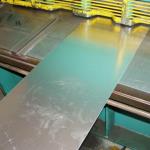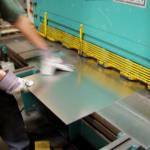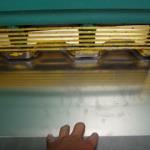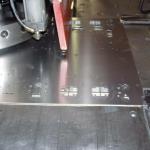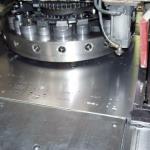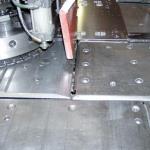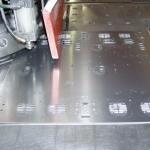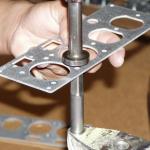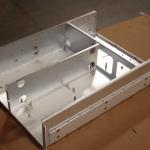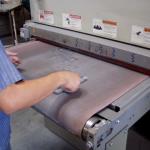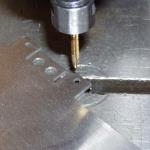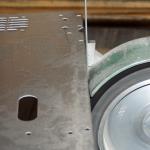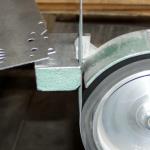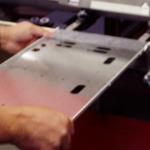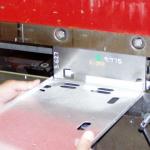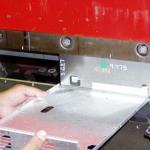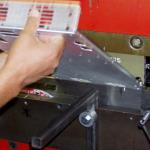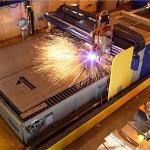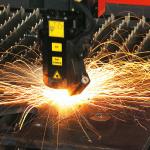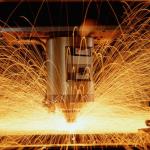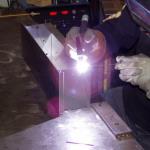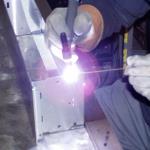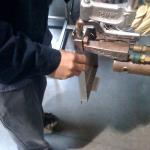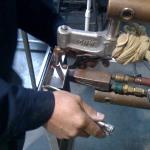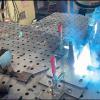Services
Shearing
Shearing is a metalworking process which cuts stock without the formation of chips or the use of burning or melting. Strictly speaking, if the cutting blades are straight the process is called shearing; if the cutting blades are curved then they are shearing-type operations.
NC Turret Press
Punch Press uses a process of operation that begins with the CNC controller commanding the drives to move a particular axis to a desired position. Once in position, the control initiates the punching sequence and pushes the ram to Bottom Dead Centre and returns it to Top Dead Center.
The punch enters the material, and pushes it through the die, obtaining the required shape of the punch and die set. This will form a piece of material that is ejected through the die and bolster plate and collected underneath the machine in scrap container.
As a metal forming process, the punch press is used for the highest volume production. Cycle times are often measured in sheet yield as a percentage of waste to parts required ratios per sheet processed. As most programming is done by skilled CAD/CAM operators parts within the sheet workpiece are commonly nested.Machine setters are mostly used to set up tooling and programming but thereafter once the machine is running an operator of low skill can oversee its continued operation. Often one operator will monitor several punch presses simultaneously making this one of the lowest cost metal manufacturing processes.
Press Brake
A press brake is a machine, used for industrial purposes, mainly for the bending of sheet metal products. Our press brakes can bend material at 10 Gauge Thinckness and at lenghts of ten foot.
Pem Serting
Pem Serting is the process of installation of self clinching fasteners and studs into sheet metal parts. These fasteners are installed per blueprint to the customers needs.
Welding
Heli arc and Short Arc & Robotic Weld
Welding is a fabrication or sculptural process that joins materials, usually metals or thermoplastics, by causing coalescence. This is often done by melting the workpieces and adding a filler material to form a pool of molten material (the weld pool) that cools to become a strong joint, with pressure sometimes used in conjunction with heat, or by itself, to produce the weld. This is in contrast with soldering and brazing, which involve melting a lower-melting-point material between the workpieces to form a bond between them, without melting the workpieces.
Spot Welding
Spot welding is a process in which contacting metal surfaces are joined by the heat obtained from resistance to electric current flow. Work-pieces are held together under pressure exerted by electrodes. Typically the sheets are in the 0.5-3.0 mm thickness range. The process uses two shaped copper alloy electrodes to concentrate welding current into a small "spot" and to simultaneously clamp the sheets together. Forcing a large current through the spot will melt the metal and form the weld. The attractive feature of spot welding is a lot of energy can be delivered to the spot in a very short time (ten to one hundred milliseconds. That permits the welding to occur without excessive heating to the rest of the sheet.
Laser Cutting
Laser cutting is a technology that uses a laser to cut materials, and is typically used for industrial manufacturing applications. Laser cutting works by directing the output of a high power laser, by computer, at the material to be cut. The material then either melts, burns, vaporizes away, or is blown away by a jet of gas, leaving an edge with a high quality surface finish. Our industrial laser cutters are used to cut flat-sheet material up to .50 inch Steel, .25 inch Stainless, and .188 inch Aluminum.
Tapping/ Countersinking/Deburring/Time Saving (Line Graining)
These Processes are all part of the manufacturing process to give a finished product done per customer requirements.
CNC
CNC Machining
In modern CNC systems, end-to-end component design is highly automated using CAD/CAM programs. The programs produce a computer file that is interpreted to extract the commands needed to operate a particular machine, and then loaded into the CNC machines for production. Since any particular component might require the use of a number of different tools—drills, saws, etc.—modern machines often combine multiple tools into a single "cell". In other cases, a number of different machines are used with an external controller and human or robotic operators that move the component from machine to machine. In either case, the complex series of steps needed to produce any part is highly automated and produces a part that closely matches the original CAD design.
Tubing and Bar Stock Cutting
Tubing and bar stock can be cut to any length to your custom needs.
Local Delivery
We offer local delivery in Southern California, contact us for more information.
Millennium Metal Fabricating, Inc.
A Solar Powered Company
Precision Sheet Metal Fabrication
Prototype and Production


